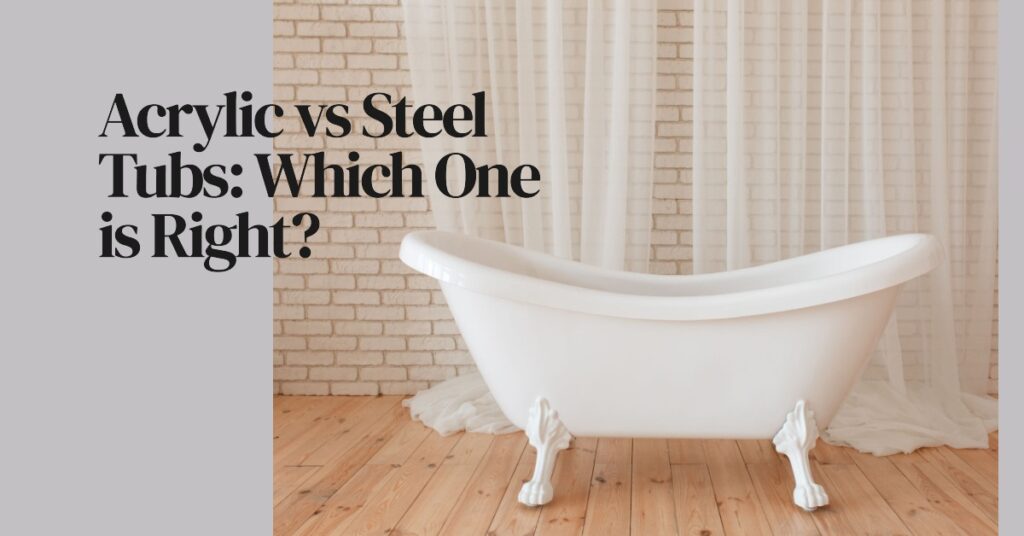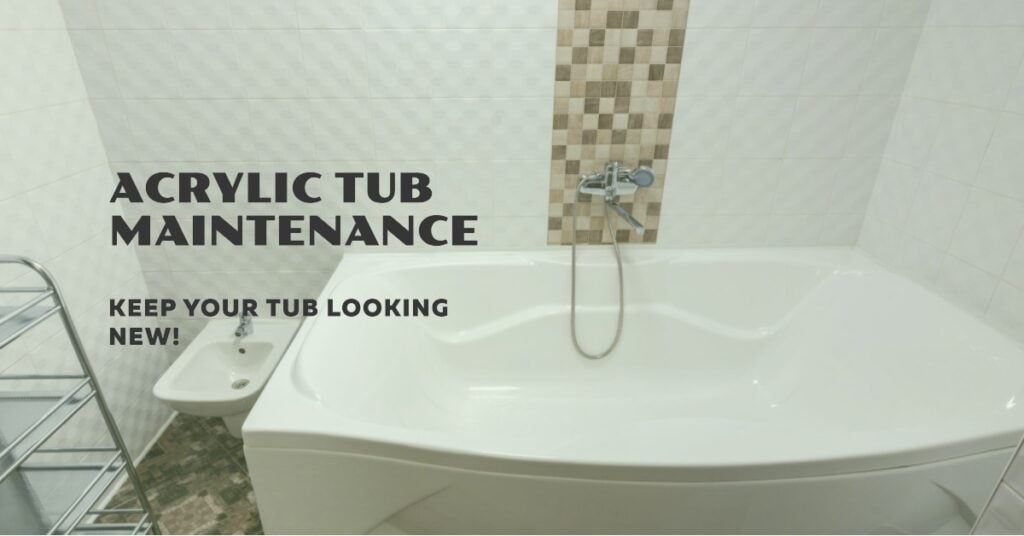
When it comes to selecting a bathtub for your bathroom, there are many options available in the market. Acrylic and steel are two of the most popular materials used for making bathtubs. Both have their advantages and disadvantages, and choosing between the two can be a difficult decision. In this article, we will take a closer look at the features of acrylic and steel tubs and help you decide which one is the best fit for your bathroom.
Quick Comparison Acrylic vs Steel Tubs
| Property | Acrylic Tubs | Steel Tubs |
|---|---|---|
| Weight | Lightweight | Heavy |
| Customizability | Highly customizable | Limited options |
| Affordability | More expensive | Less expensive |
| Durability | Susceptible to scratches and may crack or chip | Strong and durable |
| Maintenance | Prone to scratches and may lose shine over time | Resistant to scratches and easier to clean |
| Comfort | Smooth and glossy surface, retains heat well | Feels cold to the touch, may be uncomfortable for some users |
Introduction
The bathtub is a crucial element of any bathroom. It’s not only a place where you can relax and unwind after a long day but also adds to the aesthetic appeal of the bathroom. When selecting a bathtub, there are many factors to consider, including size, style, and material. Acrylic and steel are two popular materials used for making bathtubs. They have their own set of pros and cons, and it’s essential to understand these before making a decision.
Acrylic or Cast Iron Bathtub? Weighing the Pros and Cons. If you’re trying to decide between an acrylic or cast iron bathtub, our guide breaks down the benefits and drawbacks of each material to help you make an informed decision. Read more.
Acrylic Tubs
Acrylic tubs are made of a type of plastic that is reinforced with fiberglass. They are a popular choice for homeowners as they come in various shapes, sizes, and colors, making it easier to match with the bathroom’s decor.
Pros of Acrylic Tubs
- Lightweight: Acrylic tubs are much lighter than steel tubs, making them easier to install and maneuver.
- Warmth: Acrylic is an insulator, and therefore, it retains heat well, keeping your bathwater warmer for more extended periods.
- Comfort: Acrylic tubs have a smooth and glossy surface that is comfortable to the touch and is less likely to cause any skin irritation.
- Customization: Acrylic tubs can be molded into various shapes and sizes, giving you more options to choose from.
Cons of Acrylic Tubs
- Scratches: Acrylic tubs are susceptible to scratches, and over time, they may become dull and lose their shine.
- Durability: Acrylic tubs are not as durable as steel tubs and may crack or chip if heavy objects are dropped on them.
- Cost: Acrylic tubs are generally more expensive than steel tubs.
Steel Tubs
Steel tubs are made of enameled steel and are a popular choice for those who want a more traditional look for their bathroom. They are known for their durability and strength.
Pros of Steel Tubs
- Durability: Steel tubs are much more durable than acrylic tubs and can last for many years.
- Cost: Steel tubs are generally less expensive than acrylic tubs, making them a more affordable option.
- Easy to clean: Steel tubs are easy to clean and maintain, and they are resistant to scratches and chips.
Cons of Steel Tubs
- Cold: Steel is a poor insulator and may feel cold to the touch, making it uncomfortable for some users.
- Heavy: Steel tubs are much heavier than acrylic tubs and may require additional support during installation.
- Limited customization: Steel tubs come in limited shapes and sizes and are not as customizable as acrylic tubs.
Comparison
Cost
The cost of the tub is one of the most crucial factors to consider. In general, steel tubs are less expensive than acrylic tubs. However, the cost may vary based on the brand, size, and features
Durability
When it comes to durability, steel tubs are the clear winner. They are much stronger and more durable than acrylic tubs and can last for many years with proper care. Acrylic tubs, on the other hand, are susceptible to scratches and may crack or chip if heavy objects are dropped on them.
Fiberglass or Porcelain Tub? Which is Right for You? Choosing between a fiberglass or porcelain tub can be tough, but our guide makes it easy by outlining the differences between the two materials and their respective pros and cons. Read here.
Maintenance
Proper maintenance is important to keep your bathtub looking good and functioning properly. Both acrylic and steel tubs require regular cleaning to prevent buildup of dirt, soap scum, and other residues. However, the maintenance requirements for each type of tub may differ.
Acrylic Tubs

Acrylic tubs are prone to scratches and may lose their shine over time. Therefore, it’s important to use non-abrasive cleaners and avoid using abrasive sponges or cleaning tools that may scratch the surface. To remove stains or soap scum, use a mild cleaner and a soft cloth or sponge.
Avoid using harsh chemicals, such as bleach or ammonia, as they may damage the surface of the tub. If you need to use a stronger cleaner, make sure it’s approved for use on acrylic surfaces.
To maintain the shine and protect the surface of your acrylic tub, apply a coat of wax or polish once a month. This will help prevent scratches and keep the tub looking new.
Steel Tubs
Steel tubs are resistant to scratches and chips, and are generally easier to clean than acrylic tubs. However, they are susceptible to rust and may require special care to prevent rust buildup.
To clean a steel tub, use a mild cleaner and a soft cloth or sponge. Avoid using abrasive sponges or cleaning tools that may scratch the surface. To prevent rust buildup, make sure the tub is always dry and well-ventilated.
If you notice rust spots on your steel tub, you can remove them using a commercial rust remover or a solution of vinegar and water. After removing the rust, make sure to rinse the tub thoroughly and dry it completely to prevent further rust buildup.
Applying a coat of wax or polish to a steel tub can help protect the surface and prevent rust buildup. However, make sure to use a wax or polish that’s approved for use on steel surfaces.
Comfort
Acrylic tubs are more comfortable to the touch as they have a smooth and glossy surface. They also retain heat better than steel tubs, making it more enjoyable to soak in hot water. However, steel tubs can be uncomfortable for some users as they feel cold to the touch.
Make a Statement with a Freestanding Bathtub! Learn about the pros and cons of freestanding tubs, and find out how to incorporate one into your bathroom design. Click here.
Conclusion
Choosing between acrylic and steel tubs depends on your personal preferences and needs. Acrylic tubs are a better option if you’re looking for a lightweight, customizable, and comfortable bathtub. However, if you’re looking for durability, affordability, and a more traditional look, then steel tubs may be the better choice.
The answer to this question depends on personal preference and the specific needs of your bathroom. Steel tubs are generally more durable and resistant to scratches, while acrylic tubs are more lightweight and customizable. It’s important to consider factors such as budget, maintenance requirements, and design options when choosing between the two.
Stainless steel is a type of steel that contains chromium, which makes it more resistant to rust and corrosion. While stainless steel may be a good option for some bathroom fixtures, it’s not commonly used for bathtubs. Acrylic and porcelain-coated steel are the most popular materials for bathtubs.
Acrylic is a popular material for bathtubs because it’s lightweight, easy to install, and can be customized in a variety of shapes and sizes. Acrylic tubs also retain heat well and have a smooth, glossy surface that’s easy to clean. However, they may be prone to scratches and may lose their shine over time.
The best material for a built-in tub depends on your specific needs and budget. Acrylic and porcelain-coated steel are both popular options, as they are lightweight, durable, and easy to clean. Cast iron and copper tubs are also available, but they are generally more expensive and heavier.
Acrylic tubs may be prone to cracking if they are exposed to extreme temperatures or are not properly installed. However, with proper care and maintenance, acrylic tubs can last for many years. It’s important to follow the manufacturer’s guidelines for cleaning and maintenance to prevent damage to the tub.
Steel bathtubs are generally more durable than acrylic tubs and can last for many years with proper care and maintenance. However, the lifespan of a steel bathtub may be affected by factors such as exposure to moisture and rust buildup. It’s important to choose a high-quality steel bathtub and follow the manufacturer’s guidelines for cleaning and maintenance to ensure its longevity.






